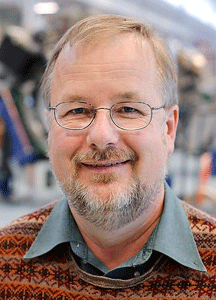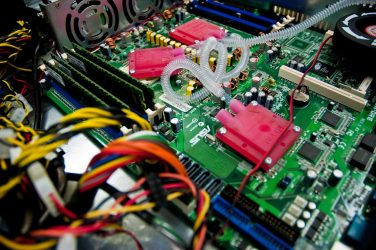Pictured above: A plastic component, made by a 3D printer in the Discovery Building, specifically built for a liquid-based cooling system that prevents computer systems from overheating.
Tools for Discovery is a monthly profile series that inspects the computer programs, gadgets and methods behind WID’s ideas and discoveries.
Thomas “Rock” Mackie is the director of the medical devices research group at the Morgridge Institute for Research, one of WID’s partners in the Discovery Building. In addition to holding positions as a professor of medical physics and biomedical engineering, Mackie also serves as the chairman, co-founder and co-inventor of TomoTherapy, Inc.

What do you work on at the Morgridge Institute for Research as a WID collaborator?
Even though I’m trained as a scientist, I view myself as an engineer. So fundamentally, I’m not discovering things; I’m trying to make things work. And that’s my goal. So I build things and my group builds things. We try to take a new approach to that process, and we have quite a broad portfolio.
We’ll design something, find out it doesn’t work and redesign it. It’s iterative, and we discover things along the way. But our goal isn’t to unlock nature; it’s to use what we’ve learned from nature to build new things that will help humanity. Our research ranges from prototyping with 3D printers to isolating medical isotopes for diagnostic tools. In a typical year we’re involved in about 70 to 80 projects, most of which come to us from outside the [Discovery] building.
“Our goal isn’t to unlock nature; it’s to use what we’ve learned from nature to build new things that will help humanity.”
-Thomas “Rock” Mackie
Tools for analysis?
A lot of our analysis is asking the question “Does this work?” and it’s often a test plan. Then, the analytics tell us how well it’s working. So, for example with the SHINE Technologies project [a company that will manufacture medical isotopes, or chemical elements needed to detect heart disease and cancer], eventually the test plan will be extremely involved, including looking at the ergonomics of design in order to run a very safe plant.
In a way, our analysis is a good test plan, which relies on the independence of components and ability to isolate them if needed. If you go look at the major prizes in science, they’re almost always awarded to people who use new instrumentation first. And the reason for that is you have competition if you’re using just instrumentation from a company. But if you’re involved in making instrumentation that can do something new, then you can be the first one to discover how it’s used in science.
Tools for writing?
Deadlines are my biggest tool. When I know something has to be finished, that’s a great tool.
My other tactic is to think about something for a long time before I start writing. I mull over it in my mind and believe we do a lot more processing in our brain than what is surfacing in consciousness. And writing is basically taking your conscience and putting it on a paper. But if you can pre-process and tumble around a problem before you put anything to paper, then when you do put it on paper, it seems effortless. And that ties into procrastination because you’re spending more time in the “tumbling around your brain” phase.
Tools for collaboration?
Well, I really like brainstorming. I like talking to people that are outside my field, and in fact, that’s who I collaborate with — people who don’t do what I do. I find it exciting to tell them things that I know, and I find it interesting to learn things from them. I like to collaborate into the unknown rather than into the known. For instance, I’ve never worked with virologists before, but now I know Paul Ahlquist and James Thomson [from the Morgridge Institute for Research], and John Yin [from WID]. I’ve worked with Michael Ferris from WID’s Optimization group before, but it’s nice to see these people all the time. I’m going to be collaborating with some of them and hope to collaborate with many more. The building really does open up that possibility.
In another sense, I think a very important collaboration is food and drink. There are a small number of people that get together at least every six weeks who go out for a beer and talk about our work. And it’s been very successful; I’ve come up with great ideas. I often go for lunch and breakfast and dinner with people. Humanity has learned to collaborate around a fire after they’ve eaten to relax. So if you can put food and drink together, that’s a step in the right direction.
Ultimate tool for discovery?
If you’re a professor, your ultimate tool is your grad students and postdocs. Having excellent people, people who are team players, who want to collaborate, is really good. Without them, you wouldn’t discover a damn thing. It’s all about the team.


You must be logged in to post a comment.